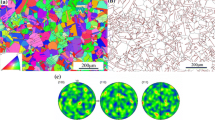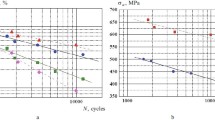Abstract
In this investigation, the effect of a frequency variation between 2 cpm and 6 × 104 cpm on the 1400°F fatigue properties of wrought Udimet 700 was determined at a constant stress range of 85 ksi. It was found that a peak existed in the cyclic life vs frequency curve such that a) an increase in frequency from 2 to 600 cpm increased the fatigue life 100 times and b) an increase in frequency from 600 to 6 × 104 cpm reduced the fatigue life sevenfold. The peak in the cyclic life vs frequency curve is the result of two competing processes: 1) there is a reduction in the effects of creep and oxidation with increased frequency that tends to increase the life and 2) there is an increase in the heterogeneity of deformation with increased frequency that tends to reduce the life. At low frequencies, crack initiation occurred at surface-connected grain boundaries. Crack propagation was initially intergranular and then proceeded noncrystallographically normal to the stress axis (Stage II mode). Crack initiation at high frequencies occurred at subsurface brittle phases located at grain boundaries or at the intersection of coherent annealing twin boundaries. Crack propagation was entirely transgranular, proceeding initially along twin boundaries or slip bands (Stage I mode) and then changing to the Stage II mode. The statistical nature of the fracture process, the significance of subsurface crack initiation, and the relation of these results to existing high temperature fatigue models are discussed.
Similar content being viewed by others
References
N. Stephenson: Memorandum No. M. 320, National Gas Turbine Establishment, Pyestock, Hants, England, June 1958.
G. P. Tilly: Current Papers No. 786, Ministry of Aviation, England, December 1963.
J. E. Northwood, R. S. Smith and N. Stephenson: Memorandum No. M. 325, National Gas Turbine Engine Establishment, 1959.
J. F. Eckel:Appl. Mater. Res., 1965, vol. 4, p. 239.
A. Coles, G. J. Hill, R. A. T. Dawson, S. J. Watson:Thermal and High Strain Fatigue, p. 270, The Metals and Metallurgy Trust, London, 1967.
L. F. Coffin, Jr.:Fracture 1969, Proceedings of the Second International Conference on Fracture, p. 643, Chapman and Hall, Ltd., 1969.
L. F. Coffin, Jr.:Proceedings of the Air Force Conference on Fatigue and Fracture of Aircraft Structures and Materials, Miami Beach, December 1969, in press.
S. S. Manson, G. R. Halford, and D. A. Spera: A. E. Johnson Memorial Volume, in press.
S. S. Manson:Exp. Mech, 1965, vol. 5, p. 193.
E. G. Ellison and C. P. Sullivan:Am. Soc. Metals, Trans. Quart, 1967, vol. 60, p. 88.
M. Gell and G. R. Leverant:Acta Met., 1968, vol. 16, p. 553.
M. Gell and G. R. Leverant:Trans. TMS-AIME, 1968, vol. 242, p. 1869.
M. Gell and G. R. Leverant:Fracture 1969, Proceedings of the Second International Conference on Fracture, p. 565, Chapman and Hall Ltd., Brighton, England, 1969.
M. Gell and G. R. Leverant: MERL, Pratt & Whitney Aircraft, Middletwon, Connecticut, unpublished research, 1970.
G. R. Leverant and M. Gell: MERL, Pratt & Whitney Aircraft, Middletown, Connecticut, unpublished research, 1970.
F. P. Bullen, A. K. Head, and W. A. Wood:Proc. Roy. Soc, London, 1953, vol. 216A, p. 332.
W. P. Mason and W. A. Wood:j. Appl. Phys., 1968, vol. 39, p. 5581.
W. A. Wood and W. P. Mason:j. Appl. Phys., 1969, vol. 40, p. 4514.
C. H. Wells and C. P. Sullivan:Am. Soc. Metals, Trans. Quart, 1964, vol. 57, p. 841.
D. J. Duquette, M. Gell, and J. W. Piteo:Met. Trans., 1970, vol. 1, p. 3107.
L. H. Burck, C. P. Sullivan, and C. H. Wells:Met. Trans., 1970, vol. 1, p. 1595.
Author information
Authors and Affiliations
Rights and permissions
About this article
Cite this article
Organ, F.E., Gell, M. The effect of frequency on the elevated temperature fatigue of a nickel-base superalloy. Metall Trans 2, 943–952 (1971). https://doi.org/10.1007/BF02664223
Received:
Issue Date:
DOI: https://doi.org/10.1007/BF02664223




